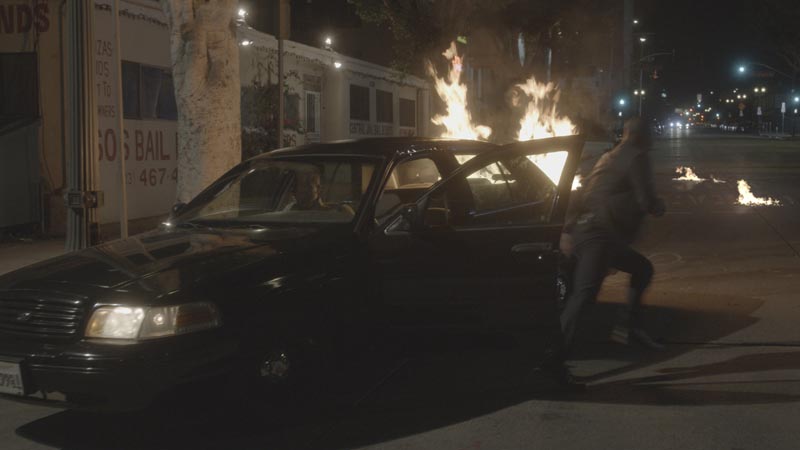VFX Investigation: Cracking the “Bosch” Case

Moving Target uses Fusion 9 Studio on the hit Amazon Prime Video streaming series
Based on the best-selling Michael Connelly novels, “Bosch” is a Prime Original series that follows Los Angeles Homicide Detective Harry Bosch (Titus Welliver). During the recently premiered fourth season, an attorney is murdered on the eve of his civil rights trial against the LAPD, and Bosch must lead a task force to try to solve the crime before the city erupts. With the spotlight turning back on his department and the murder intertwining with another, Bosch is forced to pursue every lead while struggling to reconcile his past.
Visual effects (VFX) house Moving Target has worked on the long-running series since its first season. According to Compositor Jeremy Nelson, doing VFX for a streaming series allows for more creativity and refinement, since there aren’t the same time constraints as other episodic work. “I prefer working on streaming shows because you’re working on the whole season at once. The schedule is more like working on a movie, which gives you more time to refine your effects. When you’re doing one episode per week, you can feel rushed at times. With ‘Bosch,’ we have time for creative freedom.”
Firing Up the Riots
As tensions escalate in the city, a riot breaks out. Protesters throw Molotov cocktails at the police, which is where Moving Target came in, using VFX to add fire and smoke to the street and the police car.
“The challenge in these shots was keeping continuity between the fire placements on the ground, as well as the car,” explains Jeremy. “The camera is constantly moving in every shot, so I had to use a combination of hand tracking and 3D tracking to get the smoke and flames to look like they were attached to their spots throughout the shot. By using Fusion 9 Studio’s 3D camera, I was able to put the fire and smoke elements on 3D image planes and easily position them in 3D space. Having a 3D track made it easy to reposition them in space without needing to retrack the shot.”
Taking It to the Matte
“I think what would surprise folks the most is that if we do our jobs correctly, you wouldn’t think there were any effects in the show,” Jeremy continues.
For example, one of Jeremy’s favorite shots from this season is a drone pull out that required multiple mattes to get it right.

“The shot starts right over our hero and pans up really high, showing lots of palm trees, a sidewalk and a busy street,” says Jeremy. “For the shot, I was tasked with getting rid of a lot of production crew members and production trucks, along with certain cars while keeping others. Because the pull out was so long, I had to make and project eight different matte paintings from eight different cameras throughout the shot, replacing half the road and all of the sidewalk. Then using a mix of Fusion 9 Studio’s Delta Keyer and Chroma Keyer, I was able to key most of the treetops back over the top of the matte painting, and then rotoscope the tree trunks and lamppost back in.”
Giving A Hand

For a different shot, Jeremy and the team at Moving Target had to enhance a prosthetic hand that looked too decayed, so they used a combination of projection and grid warping.
“First, a matte painting was made, and then I made a 3D object that looked like the thumb. I then loaded the thumb and animation into Fusion 9 Studio and projected the new thumb onto the moving 3D thumb,” explains Jeremy. “When I previewed the shot, I noticed that it was 90% there but still needed a little love. So, I used Fusion 9 Studio to add a grid warp to the still image of the matte painting before it was projected. Adding it that way was easier to work with than if I had put the grid warp after it was projected. From there I made a few little warps and boom, it was done.”
Having worked on the series since season one, Jeremy relies on Blackmagic Design’s Fusion 9 Studio for his VFX work on the show, along with using DaVinci Resolve to help render footage and a Production Camera 4K to capture elements for VFX shots.
“For this season, Fusion 9 Studio’s new Delta Keyer and Planar Tracker came in handy,” Jeremy concludes. “In general, I rely on Fusion 9 Studio’s 3D compositing system for all of my projects, along with its rotoscoping tools. For me, it comes down to being able to work in the node and console views. When you have an error in your comp, using the two views makes it easy to identify and fix the issue. Also, the ability and ease of being able to copy and paste nodes across a sequence into each shot’s composite really helps with continuity, and I love how easy it is to set up network rendering with Fusion 9 Studio’s unlimited render nodes.”
About Moving Target Founded by Alan Munro, director, and Brian Jochum, executive producer, Los Angeles-based Moving Target has made its mark on countless feature films, television shows and commercials. For more information, visit http://movingtargetla.com.

